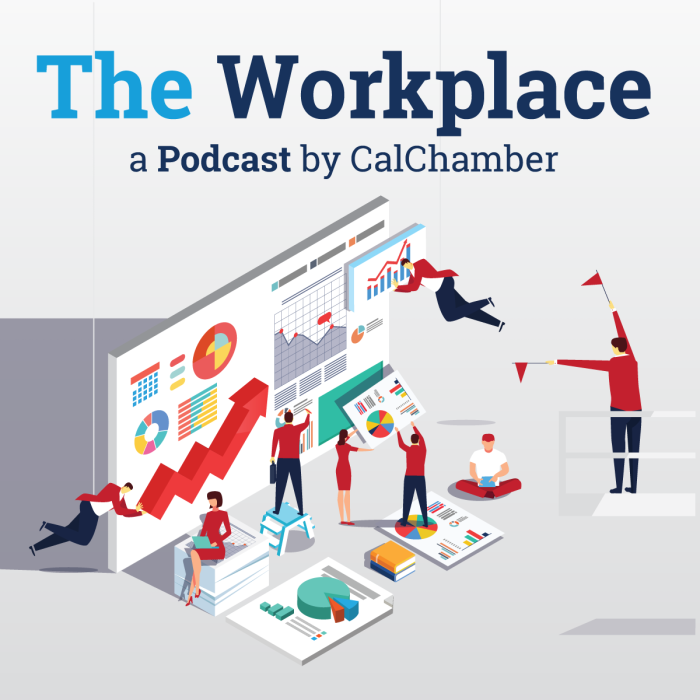
In Episode 178 of The Workplace podcast, CalChamber employment law expert Matthew Roberts sits down with CalChamber Policy Advocate Robert Moutrie to discuss the newest developments in California’s indoor heat regulations and proposed legislation, SB 553, dealing with workplace violence rules.
Indoor Heat Regulations
California has had outdoor heat protections going back a number of years, requiring employers to have a plan to deal with heat illness, Moutrie says. The state also has special high heat procedures that employers must follow when outdoor temperatures reach 95 degrees — a higher level of action in the same areas as at lower temperatures, such as providing shade and water and making sure workers get acclimatized to the higher temperatures.
This year, the California Division of Occupational Safety and Health (Cal/OSHA), which handles the implementation and enforcement of workplace safety rules, has been hard at work on proposed indoor heat rules, Roberts says.
What are these rules and what’s their status, Roberts asks Moutrie?
Moutrie explains that the indoor heat regulation package finished its 45-day comment period in May and Cal/OSHA is now in the late stage of rulemaking. The exact timeline is not yet known, but Cal/OSHA experts are now reviewing comments submitted by the CalChamber and others. Cal/OSHA staff will then decide whether changes are necessary and, if so, make them before they put the package before the Cal/OSHA board for a vote. The vote may take place later this year, but it also could be stretched as far as early 2024.
The proposed rules would establish a default trigger starting at 82 degrees, meaning that if a workplace is below 82 degrees, the regulation wouldn’t take effect. Once the temperature in a workplace rises above 82 degrees, the regulation will go into effect. The issue with this trigger, Moutrie says, is that it doesn’t take duration into consideration. So even if a workplace goes over 82 degrees for one minute, compliance obligations would be triggered.
Another concern is that a worker could transition between indoor and outdoor heat regulations for momentary tasks. For example, Roberts says, if an outdoor employee goes into an enclosed tool shed to grab a shovel, and the shed space is hotter than 82 degrees, it will trigger the indoor heat rule.
The indoor heat regulations contain some rules similar to the outdoor heat regulations. For example, employers will also have to create a heat illness prevention plan, train their employees on it, and ensure that water is accessible, Moutrie explains.
One important distinction, however, is that instead of providing a shaded space, employers will need to provide a cooldown space or room.
This requirement will create a big issue for small businesses, particularly restaurants and smaller restaurants, because a spare room may not be available, Moutrie points out. Cal/OSHA makes an accommodation by allowing the cooldown space to be an outdoor shaded area, but this still may be an issue where an employer does not have control of the space outside their premises.
“One of the things I expect to see when this passes is you’re going to see more restaurants, especially the kind of small mom-and-pop renting space in a building ones, setting up tents just outside of their restaurants to create cooldown spaces on hot days,” Moutrie says.
Workplace Violence
In 2017, Cal/OSHA created rules on workplace violence standards specific for hospitals and health care industries, which had unique workplace violence issues arising, Roberts explains. This year, California legislators are attempting to establish a workplace violence standard that would apply to all businesses via SB 553 (Cortese; D-San Jose).
The problem with this proposal is it essentially takes the hospital standard and applies it to every business in the state — even down to those with just one employee, Moutrie says.
This is concerning because it’s not feasible for a small business to do what a hospital does. Hospitals may have upwards of 1,000 employees, with access to lawyers and doctors and significant financial resources. It’s not feasible to expect a small business, such as a food truck or small nonprofit, to meet the same standards as hospitals, he stresses.
Under SB 553, employers will need to create detailed logs of workplace violence incidents, create a workplace violence plan, train employees on how to deal with the plan, and conduct annual reviews on a per location basis. There also are other provisions that may be costly for small businesses, such as a requirement to make individual psychological counseling available to anyone affected by workplace violence.
Under the proposal, workplace violence would include a threat of violence, any physical contact, and even waving around something that could be deemed a weapon, whether the individual uses it or not. Even if someone is holding a broken bottle, this could be deemed workplace violence and the employer would have to offer psychological counseling for everyone who sees or experiences this, Moutrie explains.
While a hospital can afford to offer this, a small business cannot. Cal/OSHA also is drafting a workplace violence standard and it also agreed that the standard which applies to hospitals is not feasible for every industry, he says.
There are several other requirements that SB 553 imposes that would burden small businesses, such as changing where walls are, changing sightlines, installing cameras, installing alarms, hiring more staff, and having staff specifically ready and waiting to be able to respond to a workplace violence event.
If passed, SB 553 would cut off Cal/OSHA’s rulemaking process and Cal/OSHA would be compelled to use SB 553’s standard, Moutrie explains. Moreover, if SB 553 passes, it could be a long time before Cal/OSHA attempts to amend the regulations.
“I would not expect Cal/OSHA to go back and touch this again for a decade or more if it’s passed in this form,” he says. In other words, if SB 553 is passed, employers should not expect it to be cleaned up any time soon.

